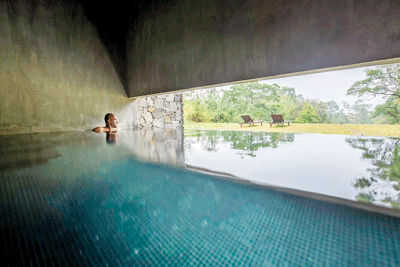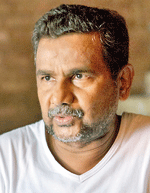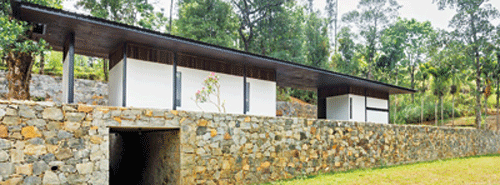Building to blend

Inside looking out: The view from the hydrotherapy pool. Pix by Thilina Wijesiri
Thanapathy’s design sees him shortlisted for the Geoffrey Bawa Award for Excellence in Architecture 2017. Having won the prestigious award back in 2011, he applied once again to share his experiences with others as well as take this as an opportunity to learn from his peers in the industry. Thanapathy explains that awards like the Bawa awards are important as they encourage architects to be more design-conscious– something he feels is lacking in our society, which has become myopic in its consumerist culture.
The Spa is the heart of the Santani Wellness Resort, the country’s only purpose built wellness resort. Built on a sprawling 48-acre estate in rural Werapitiya, the resort is just an hour’s drive from Kandy. The main complex which houses the reception and restaurant, along with the elevated chalets that dot the hillside are certainly eye catching. Their sleek minimalist design and luxurious feel have captured the imagination of many a foreign publication, from Vogue to the LA Times.
However, Thanapathy, though having designed the entire resort, chose only to submit the building that housed the spa for the award. Far more subtle than the rest, the building was conceived as a series of green terraces along the slope of the land, much like paddy terraces. The ground level consists of two pavilions constructed on pillars, which seems to be a contemporary and minimalist interpretation of the ancient Kandyan vernacular structures. A tunnel in the pavilions leads you to the lower levels. As you descend through the narrow passageway, it feels as if

Thisara Thanapathy
one is entering into a cave. The first of the two lower levels consist of a steam room, a cedarwood sauna and an open air thermal salt- soak pool. The glass wall of the sauna offers guests a view of the lush green paddy fields below and the spectacular Knuckles mountain range in the distance. The lowest level consists of three ayurvedic therapy rooms that open up one side to the surrounding paddy fields. The rubble walls of the treatment rooms and the passageways add to the cave -esque feel of the building.
Thanapathy admits that many people have been confused at his choice of submitting only the Spa for the award. “Most people ask why not the main building”. He explains that the spa, which some would consider a ‘non building’ due to its open and unimposing structure, can’t be fully appreciated by all. It challenges the concept of what a building is to those who have conditioned minds.
He recalls a story told to him when he was just a student, during a visit to Geoffrey Bawa’s Lunuganga Estate in Bentota. His lecturer told the visiting students of how once a group from Colombo had toured the gardens, and upon finishing the tour asked Bawa where the gardens were. As comical as the story sounds, it shows that a conditioned mind cannot always see what’s before them and appreciate the beauty of the unconventional. Thanapathy contrasts this with another incident at the Lunuganga Estate. He tells us of a lorry driver who was delivering construction material to the Lunuganga Estate and having walked around the gardens commented on its sereneness to Bawa. According to Thanapathy, this highlights that the mind must be unconditioned and not be boxed in by preconceived notions to appreciate the subtlety of non-conceptual architecture.
To Thanapathy, real architecture is not an imposing structure on a land with no regard to its surrounding environment. Instead it should connect with the outside and give a platform from which life can thrive. Echoing the ideas of the American professor Christopher Alexander, Thanapathy believes architecture should be built around the lives of people. “The design should capture the spirit of the place”. He believes the Spa at Santani embodies this principle.

The spa at the Santani Wellness Resort
“At the start of my career I was more concerned about the aesthetics,” he admits. But after having been in the industry for 20 years his concerns have evolved into addressing deeper issues of climate change and the stresses of life through architecture. He believes that architects should not merely satisfy their clients’ needs but that they owe a responsibility to humanity as a whole–something he puts into practice in his designs. He notes that one must be conscious of the environment one builds on. For example when building on land prone to flooding Thanapathy uses lightweight material and elevates the structure using pillars, so as to minimize the impact on the eco system as well as making the structure more resilient against flooding.
In the end architecture is about life Thanapathy stresses, and when it reaches its highest level it becomes art–art which tells us where we came from and who we are presently.


